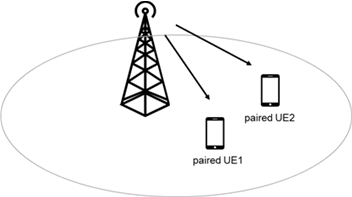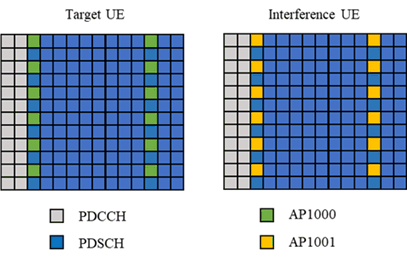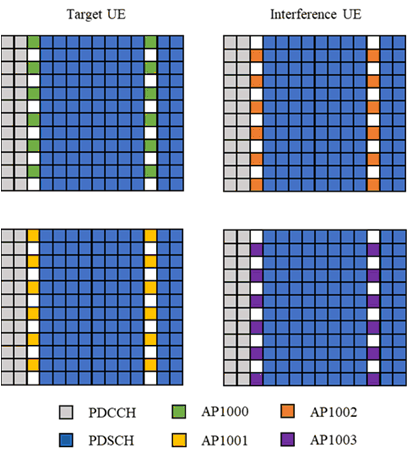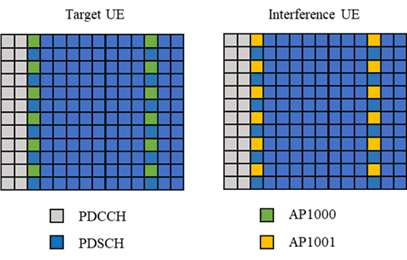TR 38.878
NR Demodulation Performance evolution
V18.2.0 (Wzip)
2024/03 … p.
- Rapporteur:
- Mr. Wu, Jingzhou
China Telecommunications
full Table of Contents for TR 38.878 Word version: 18.0.0
1 Scope
2 References
3 Definitions, symbols and abbreviations
4 Advanced receiver to cancel inter-user interference for MU-MIMO
5 Conclusions
$ Change history
1 Scope p. 6
The present technical report documents the Phase I study outcome on the advanced receiver to cancel inter-user interference for MU-MIMO, with the detailed objectives as follows:
- Evaluate and specify advanced receiver to cancel inter-user interference for MU-MIMO
-
Phase I: Study the performance gain, reference receiver assumption, interference modeling, testability, required signalling overhead, as well as impact on other WGs
-
Further discuss reference receiver assumption with below candidates
- E-MMSE-IRC
- R-ML
- Target scenario: Focus on slot based transmission
-
Further discuss reference receiver assumption with below candidates
2 References p. 6
The following documents contain provisions which, through reference in this text, constitute provisions of the present document.
- References are either specific (identified by date of publication, edition number, version number, etc.) or non-specific.
- For a specific reference, subsequent revisions do not apply.
- For a non-specific reference, the latest version applies. In the case of a reference to a 3GPP document (including a GSM document), a non-specific reference implicitly refers to the latest version of that document in the same Release as the present document.
3 Definitions, symbols and abbreviations p. 6
3.1 Terms p. 6
For the purposes of the present document, the terms given in TR 21.905 and the following apply. A term defined in the present document takes precedence over the definition of the same term, if any, in TR 21.905.
3.2 Symbols p. 6
Void
3.3 Abbreviations p. 6
For the purposes of the present document, the abbreviations given in TR 21.905 and the following apply. An abbreviation defined in the present document takes precedence over the definition of the same abbreviation, if any, in TR 21.905.
AL
Aggregation level
AP
Antenna port
BWP
Bandwidth part
CBW
Channel bandwidth
CDM
Code division multiple
CORESET
Control resource set
CSI-RS
Channel state information reference signal
DCI
Downlink Control Information
DMRS
Demodulation reference signal
E-MMSE-IRC
Enhanced Minimum mean square error - interference rejection combining
FD-CDM
Frequency division - code division multiple
FDD
Frequency Division Duplex
FDRA
Frequency domain resource allocation
HARQ
Hybrid Automatic Repeat Request
MCS
Modulation and Coding Scheme
MMSE-IRC
Minimum mean square error - interference rejection combining
MU-MIMO
Multi-user-Multiple Input Multiple Output
NZP
Non-zero-power
OFDM
Orthogonal Frequency Division Multiplexing
PDSCH
Physical Downlink Shared Channel
PRG
Precoding resource block group
PSS
Primary synchronization signal
PT-RS
Phase-tracking reference signal
QAM
Quadrature Amplitude Modulation
QCL
Quasi co-location
RB
Resource block
RE
Resource element
R-ML
Reduced complexity Maximum likelihood
RRC
Radio Resource Control
SCS
Subcarrier spacing
SNR
Signal-to-noise ratio
SSB
Synchronization signal block
SSS
Secondary synchronization signal
TBS
Transport block size
TCI
Transmission configuration indicator
TDL
Tapped delay line
TDRA
Time domain resource allocation
TM
Transmission mode
ULA
Uniform Linear Array
4 Advanced receiver to cancel inter-user interference for MU-MIMO p. 7
4.1 Scenario and interference modelling p. 7
4.1.1 Scenario p. 7
MU-MIMO allows gNB to transmit data to multiple UEs in the same time-frequency resources through spatial multiplexing. The process of selecting paired UEs is called 'pairing'. As illustrated in Figure 4.1.1-1, UE1 and UE2 are paired and gNB transmits data to both UEs with suitable precoders through the same time-frequency resources. However, the gNB cannot guarantee the perfect pairing of multiple users in the real network. The paired UEs may not perfectly spatially orthogonal to each other and this will induce the intra-cell interference between paired UEs.

Figure 4.1.1-1: gNB transmit data to paired UE1 and UE2 with the same time-frequency resources
(⇒ copy of original 3GPP image)
(⇒ copy of original 3GPP image)
To evaluate the 4 of UE with intra-cell interference induced by spatial multiplexing, the following scenarios illustrated from Figure 4.1.1-2 to Figure 4.1.1-3 are considered for the case of number of paired UEs is 2. Moreover, scenario illustrated in Figure 4.1.1-4 is considered for the case of number of paired UEs is 3.
-
Target UE with single DMRS antenna port:
-
Scenario 1: Number of CDM group without data is 1
- AP1000 for target UE, AP1001 for interference UE
-
Scenario 1: Number of CDM group without data is 1
-
Target UE with two DMRS antenna ports:
-
Scenario 2: Number of CDM group without data is 2
- AP1000 and 1001 for target UE, AP1002 and 1003 for interference UE
-
Scenario 2: Number of CDM group without data is 2
-
Target UE with single DMRS antenna port:
-
Scenario 3: Number of CDM group without data is 1
- AP1000 for target UE, AP1001 for 2 interference UEs with different frequency domain allocation.
-
Scenario 3: Number of CDM group without data is 1

Figure 4.1.1-2: Scenario 1, number of CDM group without data is 1 and AP1000 for target UE, AP1001 for interference UE
(⇒ copy of original 3GPP image)
(⇒ copy of original 3GPP image)

Figure 4.1.1-3: Scenario 2, number of CDM group without data is 2 and AP1000 and 1001 for target UE, AP1002 and 1003 for interference UE
(⇒ copy of original 3GPP image)
(⇒ copy of original 3GPP image)

Figure 4.1.1-4: Scenario 3, number of CDM group without data is 1 and AP1000 for target UE, AP1001 for 2 interference UEs with different frequency domain allocation
(⇒ copy of original 3GPP image)
(⇒ copy of original 3GPP image)
4.1.2 Interference model p. 9
...
4.2 Receiver structure p. 10
4.3 Analysis on the required information p. 11
...
4.4 Link performance characterization p. 12
4.4.1 Parameters for link level evaluation p. 12
...
4.4.2 Link level simulation results p. 14
...
4.4.3 Summary of link level evaluation p. 18
...
5 Conclusions p. 21
This technical report has documented the RAN4 evaluation on techniques to cancel downlink intra cell inter-user interference. The major work includes the determination of network scenario, interference modelling, interference suppressing receiver structure, required information analysis for each candidate receiver, link-level simulation parameters and performance evaluations.
MU-MIMO scenario with gNB transmits PDSCH to the paired UEs through the same time-frequency resources is evaluated.
gNBs equipped with 2Tx and 4Tx antennas are considered in the RAN4 performance evaluation. However, for the UEs capable of inter-user interference suppression ability discussed in this TR, they can also be used in the deployments with larger number of Tx ports configuration. For the interference suppressing receiver, both E-MMSE-IRC and R-ML are evaluated as candidate advanced receivers.
RAN4 reaches consensus on the required information for both E-IRC and R-ML receiver. In addition, RAN4 has agreed the network default configuration assumptions. Therefore, the advanced receiving algorithm can be performed under these default assumptions. For some of the default assumptions, it is required for the network to indicate the UE whether the default assumption is valid or not by RRC signalling. For UE with R-ML receiver, DCI based network assistant signalling is required.
PDSCH link-level simulations are performed to evaluate the performance gain of the candidate E-IRC and R-ML receiver over the baseline MMSE-IRC receiver under intra-cell inter-user interference scenario. 16 simulation cases that covers the advanced receiver with genie-aided required information, with co-scheduled UE DMRS port and FDRA information blind detection, and with co-scheduled UE modulation order blind detection (for R-ML receiver only), are selected for the evaluation. Different antenna and rank configurations for target and interference UEs, different propagation condition, and CBW configurations are included.
Based on the simulation results, the performance gain of R-ML receiver over the baseline MMSE-IRC receiver is verified.
Based on the above evaluations, it is recommended to select R-ML as the new advanced receiver for inter-user interference suppression receiver for MU-MIMO scenario in Rel-18, and to introduce necessary new UE capability and network assistant signalling for the selected receiver.
It is also recommended to define NR PDSCH demodulation requirements for the selected inter-user interference suppression receiver for MU-MIMO scenario in Rel-18.